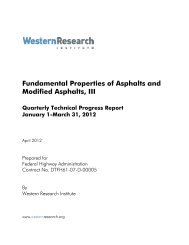Fundamental Properties of Asphalts and Modified Asphalts, III
Fundamental Properties of Asphalts and Modified Asphalts, III
Fundamental Properties of Asphalts and Modified Asphalts, III
You also want an ePaper? Increase the reach of your titles
YUMPU automatically turns print PDFs into web optimized ePapers that Google loves.
limestone. Major RA elemental oxides are CaO (39%), <strong>and</strong> SiO2 (17%). Major mineral<br />
components are calcite (61 %), quartz (7.4%), <strong>and</strong> organics (5%) [Robl 1991].<br />
FTIR-PA analysis was performed on RD <strong>and</strong> RA aggregate batched to the gradation shown in<br />
table 2-2.2.2.<br />
FTIR-PA analysis on the Arizona aggregate was performed on the minus 2.36 mm plus<br />
0.425 mm aggregate from the combined Arizona plant mix aggregate. Lime (approximately 1%<br />
by mass <strong>of</strong> the aggregate) may have been added before aggregate samples were collected on the<br />
project.<br />
Laboratory prepared mastic<br />
Table 2-2.2.2. Gradation for fine, dense graded mastic.<br />
Sieve Size, mm Percent Passing<br />
1.19 100<br />
0.600 75<br />
0.300 50<br />
0.150 30<br />
0.075 20<br />
Mastics were prepared by mixing aged AAD-1 asphalt (RTFO/PAV 80˚C, 480 hours) with RD<br />
<strong>and</strong> RA aggregate (see table 2-2.2.2 for mastic gradation). Four relative concentrations <strong>of</strong> each<br />
mastic were prepared: 20% aggregate/80% asphalt, 50% aggregate/50% asphalt, 80%<br />
aggregate/20% asphalt, <strong>and</strong> 90% aggregate/10% asphalt.<br />
Laboratory aged compacted specimens<br />
Four 75-mm diameter by 120 mm tall compacted specimens were received from North Carolina<br />
State University (NCSU, Dr. Y. Richard Kim). The specimens had been cored from larger 150mm<br />
diameter gyratory compacted specimens. A 9.5-mm nominal maximum sized aggregate was<br />
used to fabricate the specimens. The aggregate was a limestone obtained from a quarry in North<br />
Carolina. SHRP AAD-1 was used as the binder (6.2% by mass <strong>of</strong> the compacted specimen).<br />
Results <strong>and</strong> Discussion<br />
Asphalt Aging <strong>and</strong> FTIR Spectroscopy<br />
In this study, we report a Fourier-Transform Infrared (FTIR) spectroscopic survey <strong>of</strong> eight<br />
asphalts in unaged <strong>and</strong> laboratory aged conditions as well as several common aggregates used in<br />
road construction <strong>and</strong> combined asphalt/aggregate samples prepared in the laboratory. FTIR<br />
photoacoustic (FTIR-PA), <strong>and</strong> transmission liquid-cell techniques were employed to perform the<br />
survey. Results from the survey will be used here <strong>and</strong> in later studies to: (1) compare FTIR-PA<br />
<strong>and</strong> liquid cell techniques; (2) explore <strong>and</strong> confirm previously observed relationships between<br />
17





